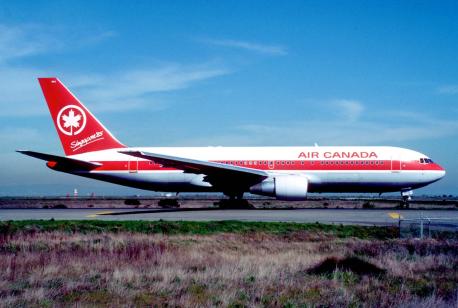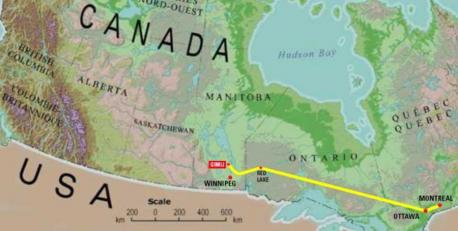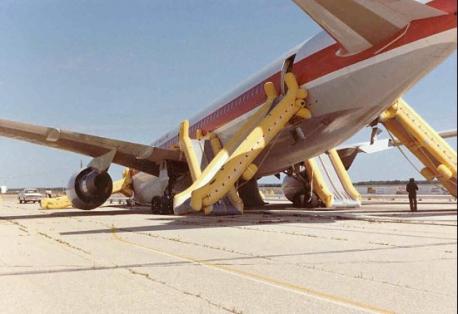Results: The Gimli Glider
Published on 03/06/2024
Air Canada Flight 143 (C-GAUN) was a Canadian domestic passenger flight between Montreal and Edmonton that ran out of fuel on Saturday July 23, 1983 at an altitude of 41,000 feet. A metric conversion mix-up before takeoff meant the plane had 45% of the fuel it needed to reach its destination, and it started running out near Red Lake, Ontario. The flight crew successfully glided the Boeing 767 to an emergency landing at a former Royal Canadian Air Force base in Gimli, Manitoba.

QUESTIONS
GO to COMMENTS
Comments
1.
1.
On July 23rd, 1983, Air Canada Flight 143 took off from Montreal, Québec, and headed towards Edmonton, Alberta with a stop in Ottawa, Ontario. Onboard the flight were 61 passengers and eight crew. The 767 was the first aircraft in the Air Canada fleet to use kilograms on the fuel gauges. The flight was piloted by 48 year old Captain Robert Pearson and 38 year old First Officer Maurice Quintal. Are you familiar with these facts?

The incident was caused by a series of issues, starting with a failed fuel-quantity indicator sensor (FQIS). These had high failure rates in the 767, and the only available replacement was also nonfunctional. The problem was logged, but later, the maintenance crew misunderstood the problem and turned off the backup FQIS. This required the fuel to be manually measured using a dripstick.
10%
190 votes
All
8%
150 votes
None
78%
1561 votes
The ground crew in Montreal loaded the fuel manually using calculations involving the specific gravity of jet fuel. But the factor they used was 1.77 pounds/litre, not the all-metric 0.8 kg/litre required for the new 767.
9%
178 votes
Instead of the 20,088 litres of fuel required for the return flight to Edmonton, the plane left with 5,000 litres. The same conversion issues occurred during another floatstick test in Ottawa.
5%
99 votes
2.
2.
Troubles started shortly after the aircraft departed Ottawa and climbed to a cruising altitude of 41,000 feet. Rapid beeps and amber warning lights were followed by displays on computer screens in front of both pilots, indicating that one of two fuel pumps in the left wing tank was failing. Pearson decided to divert to Winnipeg, the closest major airport, 120 miles to the southwest. Are you familiar with any of these facts? Quintal explained the emergency to Winnipeg Air Traffic Control and was immediately cleared to Winnipeg Airport. When Pearson began a gradual descending turn, more buzzers, lights, and displays told the crew that fuel pressure was failing in the right main tank. In minutes, the left engine failed, followed by failure of the right engine. Flight 143 was totally out of fuel.
6%
121 votes
Quintal began to calculate their rate of descent and the distance to Winnipeg, and he realized that the plane would come up some 15 miles short of the runway. Though it would mean forgoing reliable emergency assistance, Quintal urged Pearson their best hope was a nearby runway in the town of Gimli, which Quintal was familiar with from his time training in the Royal Canadian Air Force.
8%
160 votes
The plane lost all power, including its electronic instrument system. Since the electrical system ran off the engines and both engines had stopped, the cockpit was now dark, leaving Pearson and Quintal with radio and standby instruments and a $40-million-dollar glider.
5%
92 votes
The 767's radar transponder had gone dark leaving controllers in Winnipeg using a cardboard ruler on the radar screen to try and determine the 767's location and rate of descent. A magnetic compass, an artificial horizon, an airspeed indicator and an altimeter were the only instruments still working.
4%
81 votes
All
6%
123 votes
None
80%
1597 votes
3.
3.
Captain Robert Pearson was an experienced glider pilot, so he was familiar with flying techniques rarely used in commercial flight. First Officer Quintal had served in the Royal Canadian Air Force at the Gimli base, the exact landing strip they were aiming for. However, the pilots and air traffic controllers were unaware that the base had been repurposed as a race track, with an event scheduled on that day. Gimli was teeming with families, campers and go-cart racers. The airfield was full of members of the local sports racing club who were camping out on the weekend. Are you familiar with any of these facts?

As the plane approached the runway, Perason realized it was coming in too high and fast. They briefly considered a 360° turn to reduce speed and altitude, but decided they did not have enough altitude for the maneuver. Pearson decided to execute a forward slip to increase drag and reduce altitude. This maneuver is commonly used in gliders and light aircraft to descend more quickly without increasing forward speed. The nose of the aircraft pointed to the right, and its left wing pointed down toward the runway.
7%
145 votes
The pilots used a gravity drop to lower the landing gear and lock it into place. The main gear locked into position, but the lighter nose gear only partially extended. The failure of the nose wheel to lock would later prove to be an advantage after touchdown for the safety of those on the converted runway.
6%
114 votes
With both engines out of fuel, the plane hardly made any noise during its approach. People on the ground no warning of the impromptu landing and little time to flee. As the gliding plane closed in on the decommissioned runway, the pilots noticed two boys were riding bicycles within 1,000 feet of the projected point of impact.
5%
95 votes
Two factors helped avert disaster: the failure of the front landing gear to lock into position during the gravity drop, and a guardrail installed along the centre of the repurposed runway. Pearson braked hard as soon as the wheels touched down on the runway, skidding and blowing out two of the tires. The unlocked nose wheel collapsed and was forced back into its well, causing the nose to slam into the ground and then scrape along the tarmac. This additional friction helped to slow the airplane, and kept it from crashing into the crowds surrounding the runway. Pearson applied extra right brake, which caused the main landing gear to straddle the guardrail. Air Canada Flight 143 came to a final stop on the ground 17 minutes after running out of fuel.
4%
89 votes
All
7%
130 votes
None
80%
1599 votes
4.
4.
The aircraft, registration number C-GAUN, was repaired in just two days and then flown to Winnipeg for comprehensive repairs. It returned to service with Air Canada, continuing its operation until 2008. Are you familiar with any of these facts?

Following Air Canada's internal investigation, Captain Pearson was demoted for six months, and First Officer Quintal was suspended for two weeks for allowing the incident to happen. Three maintenance workers were also suspended. Following a successful appeal against their suspensions, Pearson and Quintal were assigned as crew members aboard another Air Canada flight.
7%
137 votes
Two years after the incident, Captain Pearson and First Officer Quintal were recognized for their exceptional airmanship with the first ever Fédération Aéronautique Internationale Diploma.
4%
89 votes
With the exception of a few minor injuries sustained during the evacuation, they landed without any serious injuries to the passengers, crew or people on the ground. Racers and course workers with portable fire extinguishers helped extinguish a minor fire in the nose area.
6%
127 votes
After almost 25 years of service, C-GAUN flew its last flight on January 1, 2008. The Gimli Glider then began its final voyage on January 24, 2008, as AC7067, from Montreal to Tucson International Airport and final flight to retirement at California's Mojave Airport. The flight was captained by Jean-Marc Bélanger. Captains Robert Pearson and Maurice Quintal were also on board, along with three of the six flight attendants from Flight 143.
3%
64 votes
None
80%
1609 votes
All
6%
122 votes
COMMENTS


